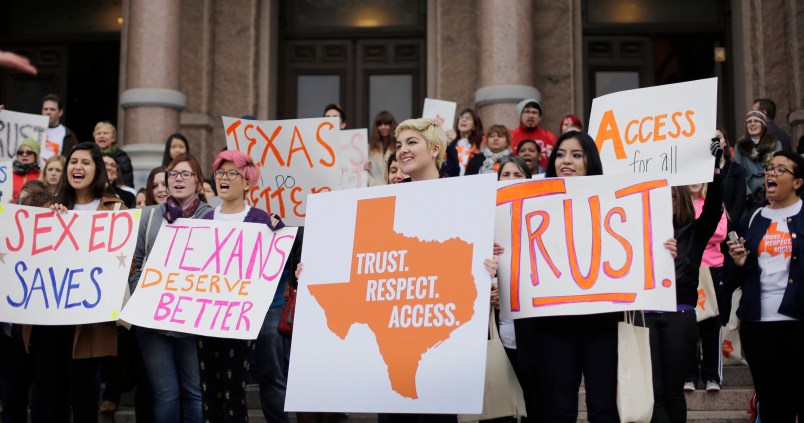UPDATE 2: June 29, 2015, 4:41 PM EDT
WASHINGTON (AP) — The Supreme Court refused on Monday to allow Texas to enforce restrictions that would force 10 abortion clinics to close.
The justices voted 5-4 to grant an emergency appeal from the clinics after a federal appeals court upheld new regulations, refusing to keep them on hold while the clinics appealed to the Supreme Court.
The Supreme Court order will remain in effect at least until the court decides whether to hear the clinics’ appeal of the lower court ruling, not before the fall.
The court’s decision to block the regulations is a strong indication that the justices will hear the full appeal, which could be the biggest abortion case at the Supreme Court in nearly 25 years.
If the court steps in, the hearing and the eventual ruling would come amid the 2016 presidential campaign.
Chief Justice John Roberts and Justices Samuel Alito, Antonin Scalia and Clarence Thomas would have allowed the state to move ahead with regulations requiring abortion facilities to be constructed like surgical centers. Doctors at all clinics also would be required to have admitting privileges at a local hospital.
The clinics said enforcing the new regulations would lead to a second major wave of clinic closures statewide in as many years. Texas had 41 abortion clinics in 2012; 19 remain.
“The justices have preserved Texas women’s few remaining options for safe and legal abortion care for the moment. Now it’s time to put a stop to these clinic shutdown laws once and for all,” said Nancy Northup, president and CEO of the Center for Reproductive Rights, which is representing the clinics in the court fight.
The regulations would have left the state with no clinic west of San Antonio. Only one would have been able to operate on a limited basis in the Rio Grande Valley.
In November 2013, Justice Stephen Breyer wrote that four justices probably would want to review the constitutionality of the regulations.
Backers of the regulations say they are common-sense measures intended to protect women. Abortion rights groups say the regulations have only one aim: to make it harder, if not impossible, for women to get abortions inTexas.
The case could be attractive to the justices because it might allow them to give more definition to the key phrase from their last big abortion ruling, Planned Parenthood v. Casey, in 1992. States generally can regulate abortionunless doing so places “an undue burden” on a woman’s right to get an abortion.
Copyright 2015 The Associated Press. All rights reserved. This material may not be published, broadcast, rewritten or redistributed.







SCOTUS on a roll as of late.
I might just be overly sensitive here, but does it make sense for progressive media to maybe not use the loaded phrase “abortion clinic” to describe women’s health centers that happen to perform abortions as one of their many services? I mean, we don’t call general practitioners “prostate fingering clinics” even though that is one of the services they perform for men.
Could be I’m wrong about the nature of the facilities in TX, too. Cancer screening? Nope. Birth control counseling and prescriptions? Nope. Pre- and post-natal wellness checks? Nope. Sorry, ma’am, all we do here is abortions.
Good.
This case will be the one that Roberts uses to get back in the good graces of the nut faction of the GOP.
I’m praying those same 5 people are still alive and on the Court in the fall when the “big” abortion rights decision happens. And I’m an atheist. . .